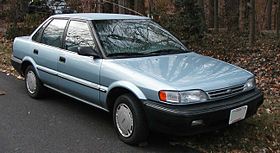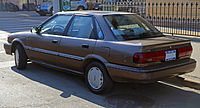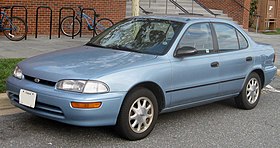Geo Prizm
This article has multiple issues. Please help or discuss these issues on the talk page. (Learn how and when to remove these template messages)
|
| Geo/Chevrolet Prizm | |
|---|---|
 | |
| Overview | |
| Also called | Geo Prizm (1990–1997) Chevrolet Prizm (1998–2002) |
| Production | 1988–2001 |
| Model years | 1989–2002 |
| Assembly | Fremont, California (NUMMI) |
| Body and chassis | |
| Class | Subcompact car (1989–1992) Compact car (1993–2002) |
| Layout | Transverse front-engine, front-wheel drive |
| Platform | Toyota E90, E100, E110 platforms (known within GM as the S platform) |
| Chronology | |
| Predecessor | Chevrolet Nova |
| Successor | Pontiac Vibe Chevrolet Cobalt |
The Geo Prizm and Chevrolet Prizm were compact cars that were rebadged versions of the Toyota Sprinter, a vehicle that the Japanese automaker Toyota never directly sold in the North American market. The Sprinter itself was derived from the Toyota Corolla. The Prizm was marketed under the Geo nameplate until it was discontinued after the 1997 model year. After that, the vehicle was marketed under the Chevrolet nameplate. General Motors (GM) referred to this and other Toyota Corolla derived vehicles as the GM S platform. The cars were produced from 1988 to 2002 alongside the Corolla at NUMMI, an assembly plant operated as a joint venture of GM and Toyota. The Prizm was sold exclusively in the United States and succeeded the 1985–1988 Chevrolet Nova, which was also derived from the Sprinter and produced at NUMMI.
Production[]
All Prizms were built at NUMMI (New United Motor Manufacturing, Inc.), a joint venture company between Toyota and General Motors in Fremont, California. The NUMMI plant at Fremont had manufactured the Prizm's predecessor, the Chevrolet Nova, and would later manufacture the Pontiac Vibe, one of its replacements. The last Prizm was built on December 13, 2001, resulting in a brief 2002 model year.
First generation (E90)[]
| First generation (E90) | |
|---|---|
 | |
| Overview | |
| Also called | Toyota Sprinter |
| Production | 1989–1992 |
| Model years | 1990–1992 |
| Designer | Hiroshi Kawahara (1985) |
| Body and chassis | |
| Body style | 4-door sedan 5-door hatchback |
| Related |
|
| Powertrain | |
| Engine |
|
| Transmission |
|
| Dimensions | |
| Wheelbase | 95.7 in (2,431 mm) |
| Length | 170.7 in (4,336 mm) |
| Width | 65.2 in (1,656 mm) |
| Height | 52.4 in (1,331 mm) |
The Prizm was introduced in February 1989 for GM's then-new Geo brand of import cars, for the 1990 model year.[1] The hatchback version sold through 1991 was a rebadged version of the Toyota Sprinter Cielo, although unlike the Sprinter (and Corolla liftback) it received the same front clip as the sedan. The sporty GSi model of 1990–1992 was notable for its 130 hp (97 kW) twin-cam engine, sport suspension, disc brakes, and 14-inch wheels, a successor to the 1988 Nova twin-cam but less of a limited edition, available in both body styles and a full array of colors in contrast to the earlier model's black sedan only. They were the only four-door models offered with the 4A-GE engine in America, no Toyota model ever offered that combination. The regular engine offered 102 hp (76 kW).[1] In addition to the base and the GSi, there was also a better equipped standard-engine LSi model. In addition to more equipment, the LSi also received body colored bumpers.
In 1991, the lettering of the car's name was changed to "PRIZM" in italicized and capital letters (although the steering wheel continued to use Prizm), and the B-pillar and door frames on base models were body-colored instead of black. The Prizm was not sold In Canada, with GM offering a sedan version of the Geo Metro instead. The Geo Metro sedan was not available from Chevrolet dealers in the United States until 1995, although a Suzuki Swift-branded version was on sale from 1990. Design patents were filed by the Toyota Motor Corporation on December 6, 1985, using a final design 1:1 representation, under application number 1985-051078 and registered on July 13, 1988, under registration number 0718088-005.
Trims & options[]
- Sedan:
- base • 1990-1992
- GSi • 1990-1992
- LSi • 1990-1992
- Hatchback:
- base • 1990-1992
- GSi • 1990-1992
- LSi • 1990-1992

Geo Prizm hatchback

1990 Geo Prizm LSi sedan, rear view
Second generation (E100)[]
| Second generation (E100) | |
|---|---|
 | |
| Overview | |
| Also called | Toyota Sprinter |
| Production | 1992–1997 |
| Model years | 1993–1997 |
| Body and chassis | |
| Body style | 4-door sedan |
| Related | Toyota Corolla (E100) Toyota Sprinter |
| Powertrain | |
| Engine |
|
| Transmission | 5-speed manual 3-speed automatic 4-speed automatic |
| Dimensions | |
| Wheelbase | 97.0 in (2,464 mm) |
| Length | 173.0 in (4,394 mm) |
| Width | 66.3 in (1,684 mm) |
| Height | 53.3 in (1,354 mm) |
The Prizm's second generation, and the last under the Geo brand name, debuted in 1992. The Prizm gained more room (resulting in an upgrade to United States Environmental Protection Agency "compact" car status), a driver's-side airbag, and a new 1.8-liter four-cylinder engine optional on LSi trim. With the larger engine came a rear stabilizer bar, wider tires, and an optional automatic transmission with four speeds instead of three. A second airbag became standard in 1993; leather seats were an option on the LSi of this generation. In contrast with the Sprinters sold in Japan, this generation Prizm lacked a front stabilizer bar in its suspension.
Trims & options[]
- Sedan:
- base • 1993-1997
- LSi • 1993-1997

Third generation (E110)[]
| Third generation (E110) | |
|---|---|
 | |
| Overview | |
| Also called | Chevrolet Prizm |
| Production | 1997–2001 |
| Model years | 1998–2002 |
| Body and chassis | |
| Body style | 4-door sedan |
| Related | Toyota Corolla (E110) Toyota Sprinter |
| Powertrain | |
| Engine | 1.8 L 1ZZ-FE (LV6) I4 (gasoline) |
| Transmission | 5-speed manual 3-speed MX1 automatic 4-speed MS7 automatic |
| Dimensions | |
| Wheelbase | 97.1 in (2,466 mm) |
| Length | 174.2 in (4,425 mm) |
| Width | 66.7 in (1,694 mm) |
| Height | 53.7 in (1,364 mm) |

The Prizm's 1998 redesign coincided with the conversion of all remaining Geo models into Chevrolets, as General Motors made the decision to discontinue the Geo brand entirely after 1997. The most notable change was the new 1.8-liter engine, which was now all-aluminum, driven by a timing chain (instead of a belt), and making more power (with the same fuel economy) than the engines from the Geo years. The new all-aluminum 1ZZ-FE engine powered all Corollas, Sprinters, and Prizms, making this generation lighter than its predecessor. This new engine incorporated laser-etched valve guides directly in the block, rather than the old shrink to fit valve guides in the previous Corolla motor (4A-FE & 7A-FE). This prevented oil burning and valve guide failure.
The Prizm, alongside the Corolla, became the first car in the compact class to offer optional side airbags. All 1998 Prizms without the LSi's optional handling package (containing a front stabilizer bar) were singled out by Consumer Reports for having sloppy emergency handling; Toyota addressed the problem for 1999 by making the handling package standard. For 2000, the engine gained variable valve timing for five extra horsepower (to 125).
Due to decreased sales, low popularity, and being in competition with the Chevrolet Cavalier and GM's more direct competitor to the Corolla the Saturn S-series, the Prizm was replaced by the Pontiac Vibe starting in 2003. The Vibe was also made in tandem with a Toyota model, the Toyota Matrix, at the NUMMI plant.
The Prizm along with its Geo siblings suffered severe sales loss when the brand denomination changed from Geo to Chevrolet in 1998. The Geo models outsold the rebadged Chevrolets three to one.
Trims & options[]
- Sedan:
- base • 1998-2002
- LSi • 1998-2002
Comparison to Toyota Corolla[]
In any of its three generations, the Prizm was virtually the same car as the Toyota Corolla. It has more similarities with Toyotas during the time period it was produced than it does to other cars from Geo and Chevrolet. Its distinctions came down to minor cosmetic differences, a GM Delco radio after 1992, the non-availability of a wagon in all three generations, and the availability of a hatchback for the 1989-1992 model years (the Corolla was not offered as a hatchback in North America for those years). The third generation Prizm also featured a Delphi air conditioning system instead of the Corolla's Denso air conditioning system. All Prizms also used the contemporary Sprinter front end to differentiate them from their Corolla counterparts.
Engines[]
All Prizms are powered by engines from their contemporary Toyota Corolla models:
- 1990–1992 Geo Prizms are powered by a 4A-FE or optional 4A-GE engine
- 1993–1997 Geo Prizms are powered by a 4A-FE or optional 7A-FE engine
- 1998–2002 Chevrolet Prizms are equipped with Toyota's 1.8 L 1ZZ-FE inline-four engine; 2000–2002 models include VVT-i (variable valve timing with intelligence).
See also[]
- Chevrolet Chevy II / Nova
- Toyota Corolla (E90)
- Toyota Corolla (E100)
- Toyota Corolla (E110)
- NUMMI
- Pontiac Vibe
Bibliography[]
- 1990 Geo Prizm Sales Brochure (1990) by Geo
- 1997 Geo Prizm Sales Brochure (1994) by Geo
- 1995 Geo Prizm Sales Brochure (1995) by Geo
- 1996 Geo Prizm Sales Brochure (1996) by Geo
- 1997 Geo Prizm Sales Brochure (1997) by Geo
- 1998 Chevrolet Prizm Sales Brochure (1998) by Chevrolet
- 1999 Chevrolet Prizm Sales Brochure (1999) by Chevrolet
- 2000 Chevrolet Prizm Sales Brochure (2000) by Chevrolet
- 2001 Chevrolet Prizm Sales Brochure (2001) by Chevrolet
- 2002 Chevrolet Prizm Sales Brochure (2002) by Chevrolet
- 1989 New Car Buying Guide (1989) by Guy Henle & Consumer Reports
- 1990 New Car Buying Guide (1990) by Consumer Reports
- 1993 New Car Buying Guide (1993) by Bill Hartford & Consumer Reports
- 1994 New Car Buying Guide (1994) by Bill Hartford & Consumer Reports
- 1995 New Car Buying Guide (1995) by Bill Hartford & Consumer Reports
- 1996 New Car Buying Guide (1996) by Bill Hartford & Consumer Reports
- 1997 New Car Buying Guide (1997) by Bill Hartford & Consumer Reports
- 1998 New Car Buying Guide (1998) by Consumer Reports
- 1999 New Car Buying Guide (1999) by Consumer Reports
- 2000 New Car Buying Guide (2000) by Consumer Reports
- 2002 New Car Buying Guide (2002) by Consumer Reports
- Consumer Reports Used Car Buying Guide (1997) by Consumer Reports
- Consumer Reports Used Car Buying Guide (1998) by Consumer Reports
- Consumer Reports Used Car Buying Guide (2001) by Consumer Reports
- Consumer Reports Used Car Buying Guide (2002) by Consumer Reports
References[]
- ^ a b Kowalke, Ron, ed. (1999). Standard Catalog of Independents: The Struggle to Survive Among Giants. Iola, WI: Krause Publications, Inc. p. 267. ISBN 0-87341-569-8.
External links[]
- Compact cars
- Front-wheel-drive vehicles
- Hatchbacks
- Sedans
- 1990s cars
- 2000s cars
- Geo (automobile)
- Cars introduced in 1988
- Motor vehicles manufactured in the United States
- Toyota Corolla


